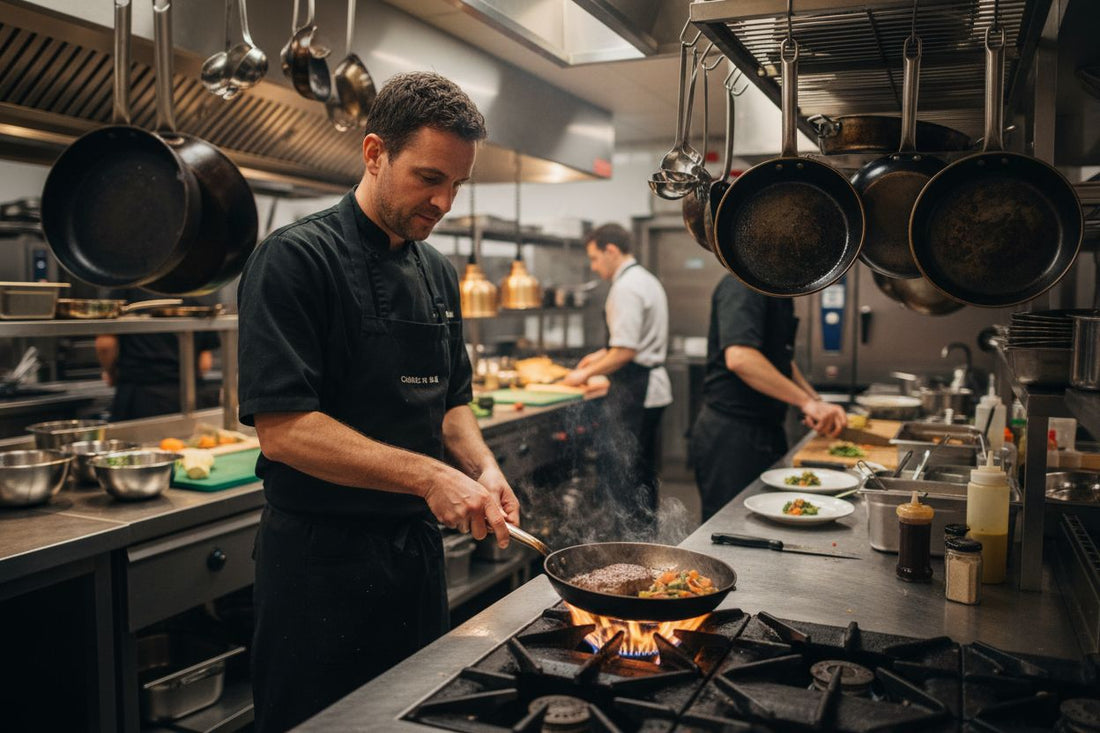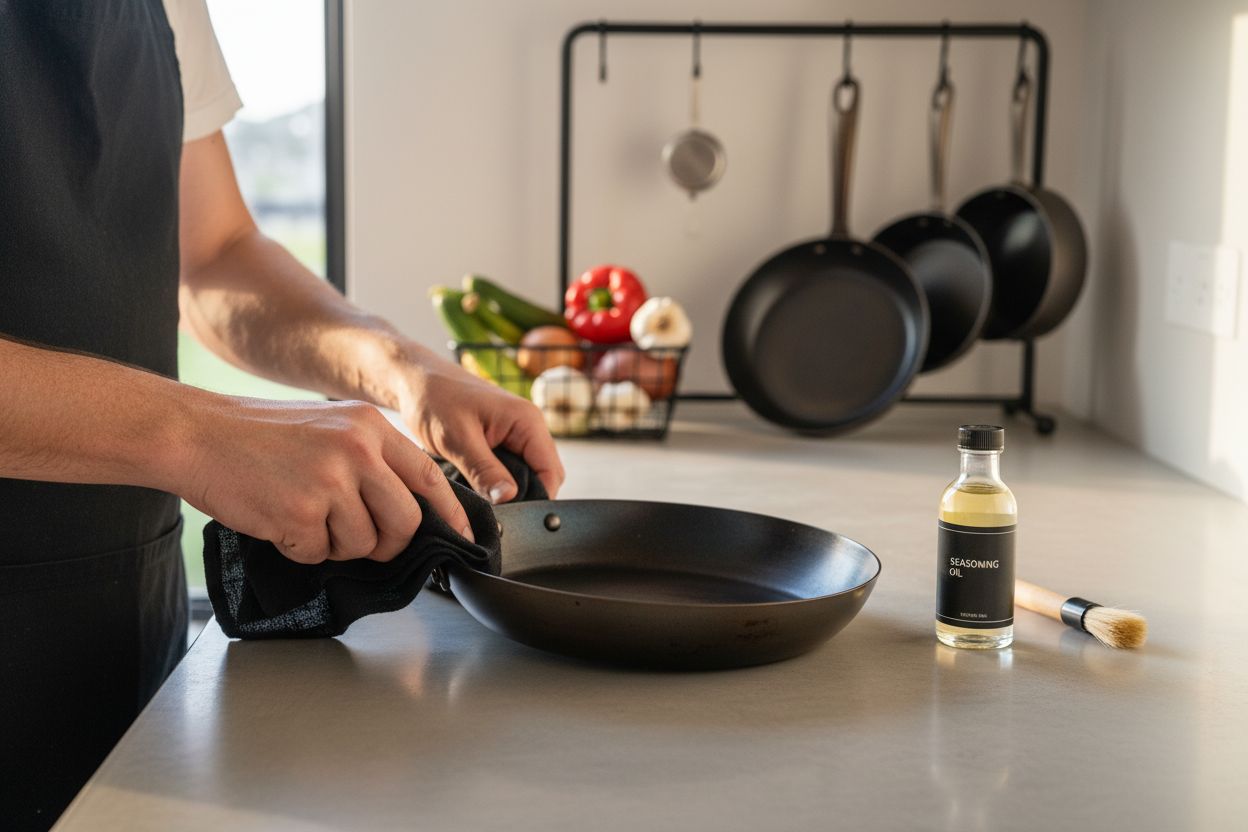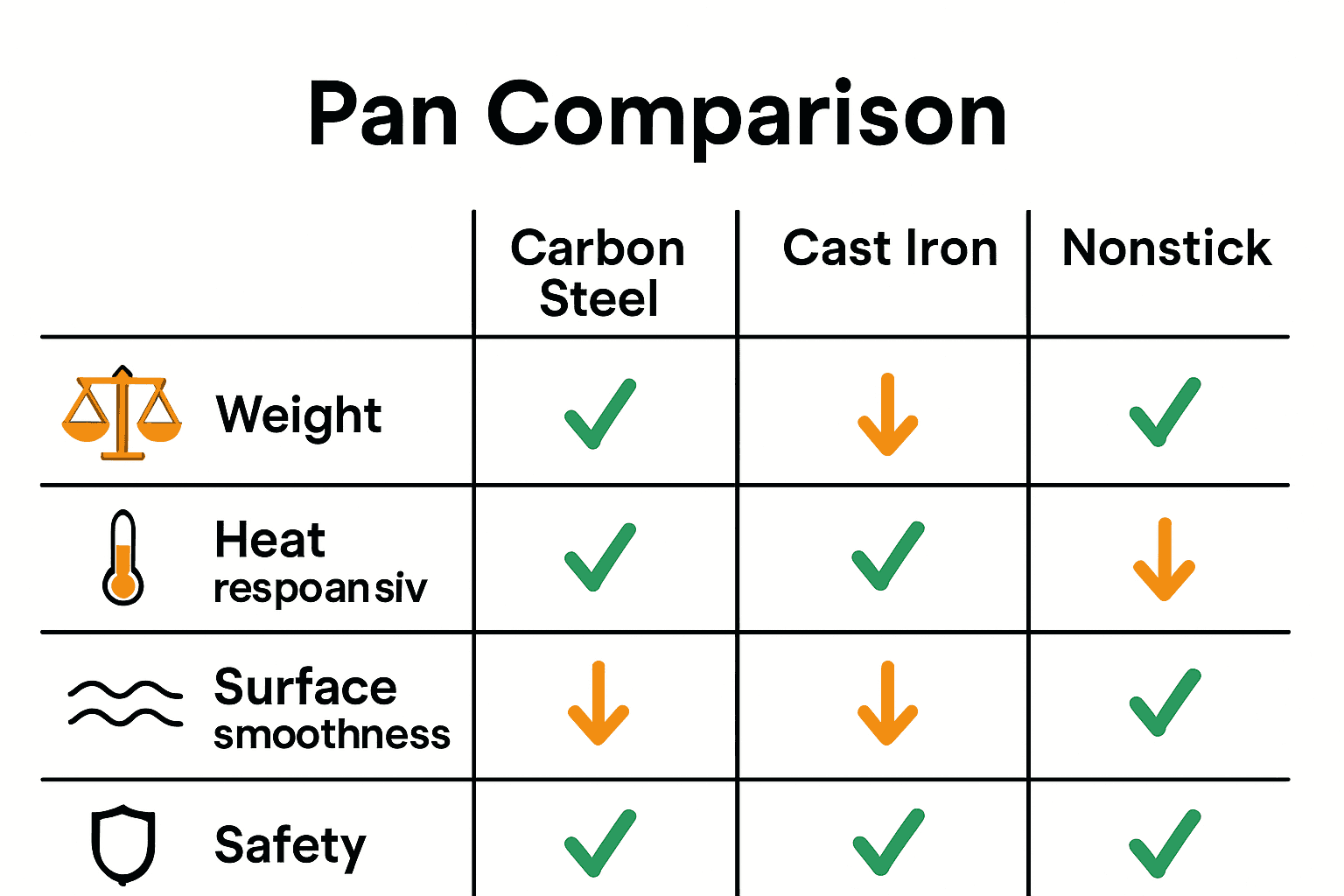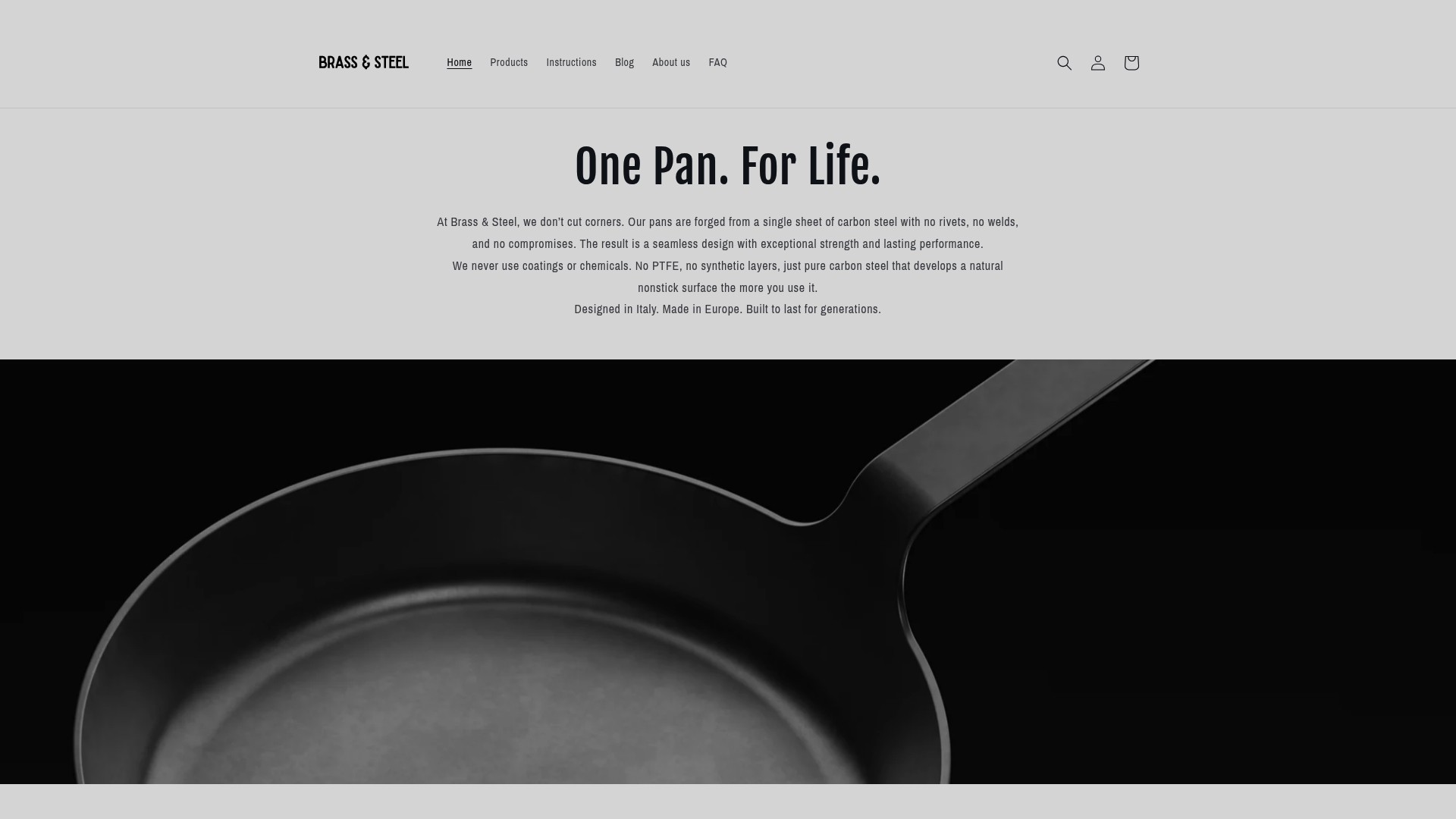
What Is Carbon Steel? Complete Guide for Cookware
Share
Nearly 70 percent of professional chefs use carbon steel pans in their kitchens, drawn by their performance and durability. For home cooks, the reputation of carbon steel often gets tangled in myths about rust or tricky upkeep. Understanding what really sets carbon steel apart can help anyone choose cookware that makes meal prep easier, tastier, and healthier. Discover how these pans blend the best features of cast iron and nonstick while sidestepping common misconceptions.
Key Takeaways
| Point | Details |
|---|---|
| Carbon Steel Characteristics | Carbon steel features a carbon content between 0.05% and 2.1%, providing excellent heat conductivity and lightweight properties for cooking. |
| Maintenance Myths | With proper care, such as drying and oiling, carbon steel cookware is durable and can last generations, debunking the myth of high maintenance. |
| Versatile Applications | Carbon steel pans are adaptable for various cooking methods, including woks, crepe pans, and sauté pans, making them a kitchen essential. |
| Safe Alternative to Nonstick | Unlike traditional nonstick cookware, carbon steel is PFAS-free and develops a natural nonstick surface through seasoning, promoting healthier cooking options. |
Table of Contents
- Defining Carbon Steel And Common Misconceptions
- Types Of Carbon Steel For Cookware Applications
- How Carbon Steel Pans Are Made
- Key Properties And Culinary Performance
- Carbon Steel Vs. Cast Iron And Nonstick Alternatives
- Care, Maintenance, And Health Considerations
Defining Carbon Steel and Common Misconceptions
When people hear “carbon steel,” they often imagine something complex or industrial. But in reality, carbon steel is surprisingly straightforward, especially in cooking. According to Wikipedia, carbon steel is defined by its carbon content, ranging from 0.05% to 2.1% by weight. This composition distinguishes it from other steel types and gives it unique characteristics.
In cookware, carbon steel isn’t just another material - it’s a culinary workhorse. Learn more about iron vs carbon steel, and you’ll discover its remarkable properties. Unlike stainless steel or cast iron, carbon steel offers a perfect balance of lightweight design and exceptional heat conductivity. When manufacturers create carbon steel pans, they typically roll or hammer thin sheets, which provides several key advantages:
- Superior heat distribution
- Rapid temperature response
- Lightweight compared to cast iron
- Develops a natural nonstick surface through seasoning
Common misconceptions about carbon steel often stem from misunderstandings about maintenance. Many home cooks believe these pans are high-maintenance or prone to rusting. In truth, with proper care - which means drying thoroughly after washing and applying a light oil coating - carbon steel cookware can last generations. The key is understanding its unique characteristics and treating it accordingly.
 Our guide on carbon steel maintenance can help you master these essential skills and unlock the full potential of this incredible cooking material.
Our guide on carbon steel maintenance can help you master these essential skills and unlock the full potential of this incredible cooking material.
Types of Carbon Steel for Cookware Applications
Carbon steel isn’t a one-size-fits-all material, but rather a versatile cooking companion with different applications tailored for specific culinary needs. Explore carbon steel cookware performance to appreciate its remarkable adaptability across kitchen scenarios.
Traditionally, carbon steel has been the go-to material for several specialized cooking vessels. According to Epicurious, carbon steel woks are particularly prized for achieving “wok hei” - that magical, smoky flavor characteristic of perfect stir-frying. Different wok designs showcase this versatility:
- Flat-bottom woks: Ideal for home stovetops
- Hand-forged woks: Preferred by professional chefs for traditional cooking techniques
- Round-bottom woks: Classic design for high-heat restaurant cooking
Beyond woks, carbon steel cookware spans an impressive range of applications. As noted by Wikipedia, carbon steel is traditionally used for:
- Crepe pans: Delivering thin, delicate pancakes
- Fry pans: Perfect for searing and high-heat cooking
- Paella pans: Ensuring authentic Spanish rice dishes
- Sauté pans: Providing exceptional heat distribution
The key is understanding each pan’s unique characteristics. Discover why chefs choose carbon steel and you’ll appreciate how this material transforms cooking from a routine task to a culinary art form.
How Carbon Steel Pans Are Made
Understanding the manufacturing process reveals why carbon steel pans are such exceptional cookware. Learn more about carbon steel pan benefits, and you’ll appreciate the craftsmanship behind these culinary tools. According to Wikipedia, carbon steel cookware is fundamentally different from cast iron, as manufacturers create these pans by rolling or hammering dense steel sheets into thin, precise shapes.
The manufacturing process involves several sophisticated techniques. As reported by Tom’s Guide, two primary methods dominate carbon steel pan production:
- Spinning: A technique where steel sheets are rotated on a lathe and shaped using specialized tools
- Stamping: Pressing steel sheets into pan shapes using high-precision dies
These methods result in key differences from traditional cast iron cookware.
Carbon steel pans are characteristically:
- Lighter in weight
- Thinner in construction
- More responsive to temperature changes
- Typically featuring riveted handles for durability
The precision of modern manufacturing allows for incredibly consistent pan performance. Explore our carbon steel pan safety guide to understand how these manufacturing techniques contribute not just to cooking performance, but also to overall kitchen safety and durability.
Key Properties and Culinary Performance
Carbon steel represents a culinary powerhouse that bridges the gap between traditional and modern cooking techniques. Discover essential professional kitchen cookware insights to understand why chefs worldwide prefer this remarkable material. According to Wikipedia, carbon steel offers robust strength and exceptional heat distribution, creating an environment that promotes perfect cooking results.
The magic of carbon steel lies in its unique surface transformation. When properly seasoned, the pan develops a polymerized oil surface that does more than prevent sticking - it actively enhances cooking. According to Delish, carbon steel pans distinguish themselves through several critical performance characteristics:
- Rapid heating: Faster temperature rise compared to cast iron
- Lightweight design: Easier handling and maneuverability
- Smoother surface: Ideal for delicate foods like eggs and fish
- Responsive cooling: Quicker temperature adjustments
The pan’s ability to trigger Maillard reactions elevates cooking from mere sustenance to culinary art. Its smooth surface and heat responsiveness allow chefs to achieve perfect browning, creating depth of flavor that transforms ordinary ingredients into extraordinary dishes. Learn more about forged cookware techniques to appreciate the engineering behind these remarkable cooking tools.
Carbon Steel vs. Cast Iron and Nonstick Alternatives
Cookware selection is more than just picking a pan - it’s about understanding the nuanced performance characteristics of different materials. Learn about nonstick alternatives to make an informed decision that balances cooking performance and health considerations. According to Tom’s Guide, carbon steel differs fundamentally from cast iron in composition, with lower carbon content and significantly different cooking properties.
When comparing carbon steel to traditional cast iron, several key differences emerge. Carbon steel contains less carbon (under 2% versus 2–3.5% in cast iron), resulting in a lighter, more responsive cooking surface. While cast iron excels at heat retention, carbon steel offers superior:
- Maneuverability: Lighter weight for easier handling
- Heat responsiveness: Quicker temperature changes
- Surface smoothness: Better for delicate foods
- Maintenance: Easier seasoning and cleaning
Moreover, Understand carbon steel versus nonstick comparisons, and you’ll discover a critical health advantage. According to The Guardian, traditional nonstick pans often contain PFAS chemicals with potential health risks. Carbon steel emerges as a PFAS-free alternative that develops a natural, safe nonstick surface through proper seasoning - offering performance without compromising your well-being.
Here’s a comparison of carbon steel, cast iron, and nonstick cookware features:

| Feature | Carbon Steel | Cast Iron | Nonstick |
|---|---|---|---|
| Weight | Light to moderate | Heavy | Very light |
| Heat Responsiveness | Rapid changes | Slow changes | Rapid |
| Surface | Smooth (seasoned) | Rougher (seasoned) | Ultra-smooth (coated) |
| Nonstick Capability | Develops naturally with use | Develops naturally with use | Immediate (chemical coating) |
| Durability | Extremely durable | Exceptionally durable | Varies; coating may wear off |
| Maintenance | Requires seasoning; easy | Requires seasoning; more effort | Minimal but coating sensitive |
| Chemical Safety | 100% PFAS-free | 100% PFAS-free | May contain chemical coatings |
| Best For | Searing, eggs, stir-fries | Baking, stews, searing | Low-fat cooking, delicate foods |
Care, Maintenance, and Health Considerations
Carbon steel requires thoughtful care to maintain its exceptional cooking performance. Learn more about alternative cookware insights to understand the nuanced maintenance of different cookware materials. According to Wikipedia, carbon steel must be seasoned to develop a protective non-stick layer, and it’s particularly susceptible to rusting if not properly dried and stored.
Cleaning and maintaining your carbon steel pan is an art in itself. As reported by Delish, effective maintenance involves specific techniques:
- Cleaning method: Use warm soapy water or salt scrubs
- Drying: Thoroughly dry immediately after washing
- Oiling: Apply a thin layer of neutral oil after cleaning
- Storage: Keep in a dry environment
From a health perspective, carbon steel stands out as a remarkably safe cookware option. Unlike traditional non-stick pans with chemical coatings, carbon steel develops a natural seasoning that improves with use. This seasoning not only provides a non-stick surface but also creates a barrier that prevents metal leaching, making it an excellent choice for health-conscious cooks who want both performance and peace of mind.
Unlock True Culinary Performance with Heirloom-Quality Carbon Steel Pans
Are you frustrated by cookware that sticks, warps or never matches up to professional results? After learning what makes carbon steel so exceptional—its single-piece forged strength, rapid heat response and natural nonstick surface—it is time to experience the difference for yourself. Discover our specialist Carbon Steel Collection, meticulously engineered in Poland and finished with minimalist Italian design. Each pan embodies the science and artistry outlined in this guide, tailored for cooks who demand reliability and culinary excellence.

Transform your kitchen routine now. Choose a professional carbon steel pan that is PTFE-free, compatible with induction, and built to last a lifetime. Visit Brass & Steel and see how your next meal can benefit from the cookware experts trust. Experience quality today—the tools you use should inspire confidence, not compromise.
Frequently Asked Questions
What is carbon steel cookware and how is it different from other types of cookware?
Carbon steel cookware is made primarily from carbon and iron, with a carbon content ranging from 0.05% to 2.1%. Unlike stainless steel or cast iron, carbon steel offers excellent heat conductivity, lightweight construction, and the ability to develop a natural nonstick surface through proper seasoning.
How do I maintain and care for a carbon steel pan?
To maintain a carbon steel pan, clean it with warm, soapy water or salt scrubs, dry it immediately, and apply a thin layer of neutral oil after cleaning. Proper storage in a dry environment helps prevent rusting.
What are the advantages of using carbon steel over cast iron or nonstick cookware?
Carbon steel pans are lighter, more heat responsive, and have a smoother surface compared to cast iron. Unlike nonstick cookware, carbon steel does not contain chemical coatings and develops a natural nonstick surface that improves with use, making it a healthier option.
Can carbon steel cookware be used for high-heat cooking?
Yes, carbon steel cookware is ideal for high-heat cooking methods, such as searing, stir-frying, and sautéing. Its ability to heat rapidly and respond quickly to temperature changes makes it an excellent choice for professional and home chefs alike.